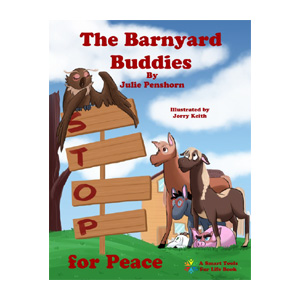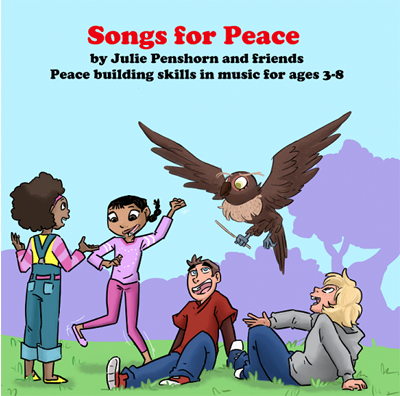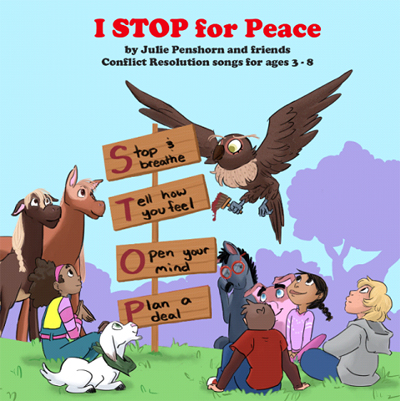
Santa visits
The Barnyard Buddies help Santa each fall.
Kids can take rides — near his booth at the mall.
So he asks them each year, “Did the kids act with care?
“Were they grateful that farmer Jim brought you all there?”

The Barnyard Buddies went to the mall to give pony rides and petting opportunities to the children.
And each year The Buddies have mixed reports
Some children terrific, others out of sorts.
“We mostly tell Santa the children are great,
“So maybe now it’s a little bit late
“But I think we should say, at least mention the fact,
“That several of the children ended up in a stack
“On the floor in a tussle just to get that new game,”
Said Ol’ Dot with a sad face, and feeling quite lame.

Boys in a tussle
She took many children up on her old back.
They made her walk fast, and she limped coming back.
“It’s true, I’m hurt. It’s silly, but heck,
“Very few children even petted my neck.
“Did they think I was a robot, a computer game?
“Not one even asked Farmer Jim for my name!”
You could tell from her face that Ol’ Dot was sad.
And the others agreed, and began to feel mad.

Santa and sleigh
Santa landed his sled on the barn roof that night.
And they told him their thoughts — it was such a sight —
The animals crying, and Santa in thought.
What to do about kids’ gifts? Maybe give coal — or not?
“Please don’t give coal, Santa! Most kids try each year.”
Said Grey Donkey to them all — shedding a tear.
“We just need a way to help children find
“There are so many reasons for them to be kind.
“Most of the time when kids have a fight
“Peace has been interrupted — someone’s heart is not right
“That book, “I Can See Peace” shows children the way
“To seek and find peace. Let’s give them that book — if we may!
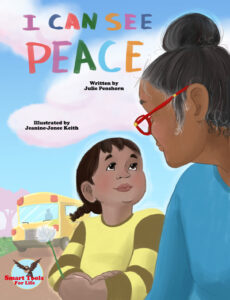
Book, I Can See Peace
“Without empathy and compassion, the future looks dire.
“So we must try harder!” said Santa, sounding tired. . .
“I’ve an idea! Tell how you all do it —
“Here in the barnyard, you get along, nothing to it!
“Yes! The owl, Mrs. McCloud taught us,” said King.
“Let’s write our stories, that’s how we can bring
“Kids the smart tools so they too can say,
“‘I feel so peaceful and connected today!’”
So now, Barnyard Buddies have a book to share
And songs you can sing when you struggle to care.
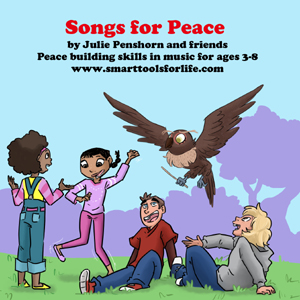
Music CD about peacemaking for children
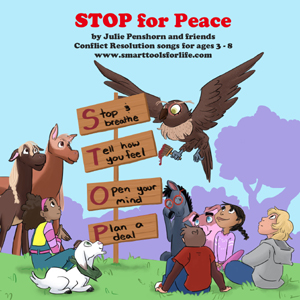
Music for conflict resolution and peacemaking
About how to solve problems, be kind, and be fair,
About how to take turns, compromise, and share.
If you ask Santa, he’ll drop off at your door
All these smart tools. That’s what they’re for!
This poem is a story about how “The Barnyard Buddies STOP for Peace” book may have come to be! I hope you enjoy and share.

Two children who love The Barnyard Buddies STOP for Peace
This blog is definitely a bit big on the marketing and promoting (at the end). If you read the reviews that are on Amazon associated with any of the materials, but particularly the music, I think you will see why I feel the need to share and promote. These materials are really important and valuable to kids — according to others. I think as the writer, it’s my responsibility to do my share to let others know about them. Please share in any way you can. Twitter, Facebook, and so on.
As you see, The Barnyard Buddies also mentioned the other award-winning book, “I Can See Peace.” The two books and two cds of music provide a lovely, simple way to bring a comprehensive peacemaking education to very young children. All the materials are targeted for ages 3 to 8 or 9.
The young ages are when we cement our conflict resolution styles. We also learn that our families value our caring and sharing behaviors. We learn about focusing on kindness and compassion, recycling, and caring for the earth, what it means to be a peacemaker and so much more. All these are addressed in the music that goes with these books.
As a person living on this heating planet, I can only hope our children grow up thoughtful, compassionate, and smart about caring for others and issues of climate change, and are willing to get to the deeper issues around population, scarcity of resources, and more that prevent our success on these issues.
Apologies for lack of diversity! This poem is not meant to leave out others, but I have only come up with this Santa story to tell the tale of how The Barnyard Buddies (with a little help from me) created “The Barnyard Buddies STOP for Peace” children’s book. Maybe next year I’ll figure out a story that works better for children with a background in other traditions!
The story of Santa doesn’t indicate any religious preference or bias by me, the staff or the organization.
